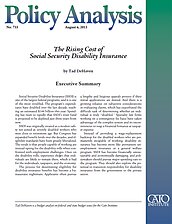SSDI was originally created as a modest safety net aimed at severely disabled workers who were close to retirement age. But Congress has expanded benefit levels over the decades, and eligibility standards have been greatly liberalized.The result is that people capable of working are instead opting for the disability rolls when confronted with employment challenges. Once on the disability rolls, experience shows that individuals are likely to remain there, which is bad for the individuals, taxpayers, and the economy.
The process for determining eligibility for disability insurance benefits has become a bureaucratic nightmare. Applicants often pursue a lengthy and litigious appeals process if their initial applications are denied. And there is a growing reliance on subjective considerations in evaluating claims, which has exacerbated the difficult task of determining whether an individual is truly “disabled.” Specialty law firms working on a contingency fee basis have taken advantage of the complex system and its inconsistencies to reap a financial bonanza at taxpayer expense.
Instead of providing a wage-replacement back stop for the disabled workers who are permanently incapable of working, disability insurance has become more like permanent unemployment insurance or a general welfare program. SSDI has become financially unsustainable and economically damaging, and policy makers should pursue major spending cuts to the program. They should also explore the potential to transition responsibility for disability insurance from the government to the private sector.

